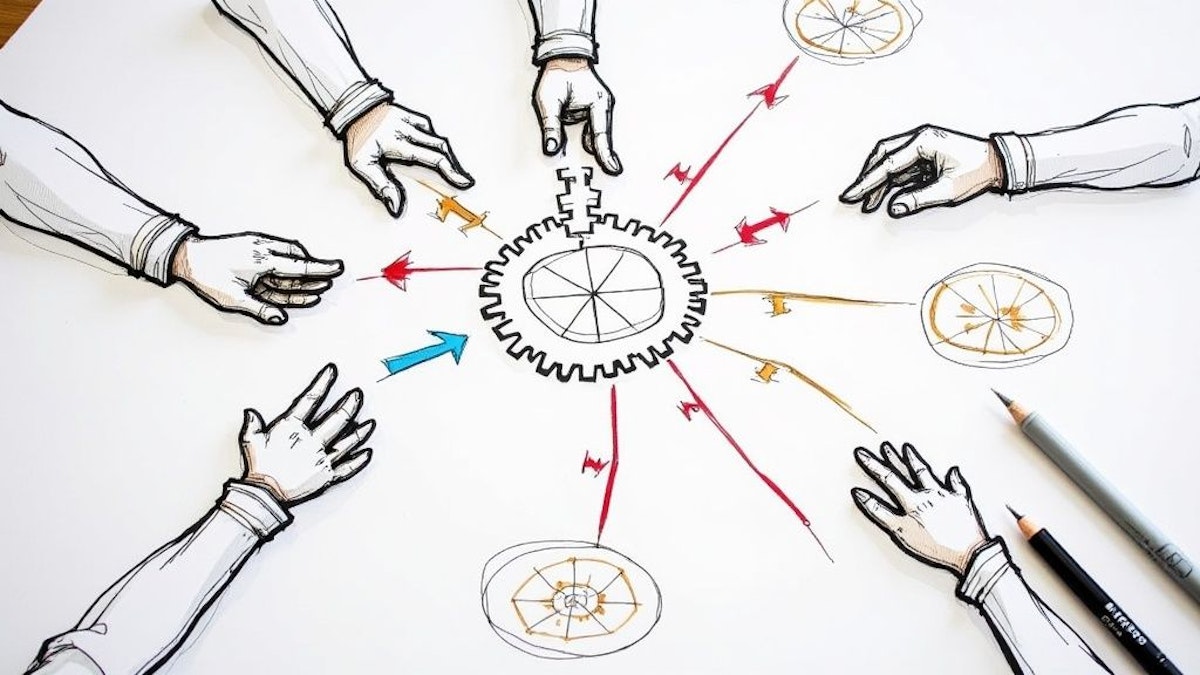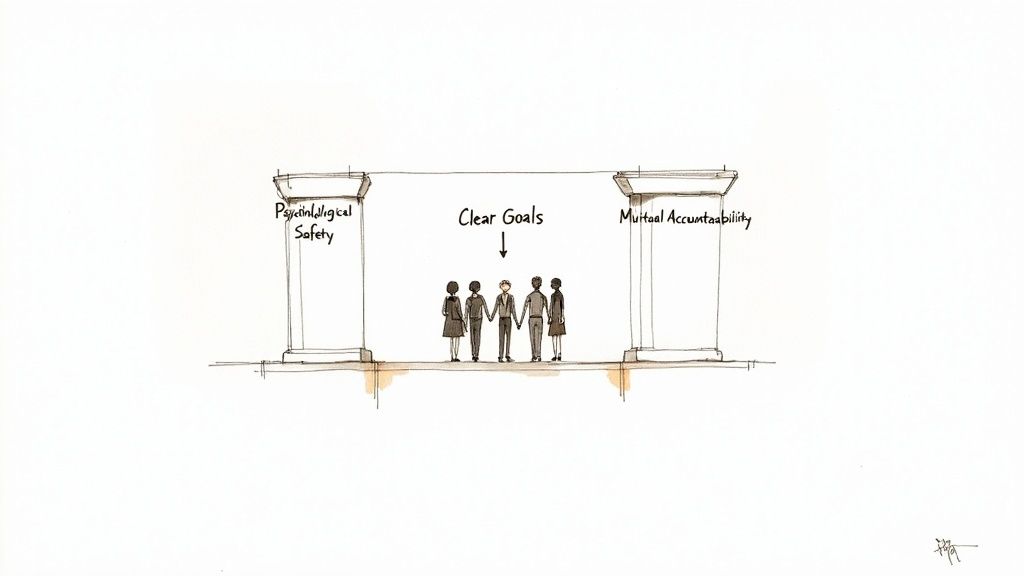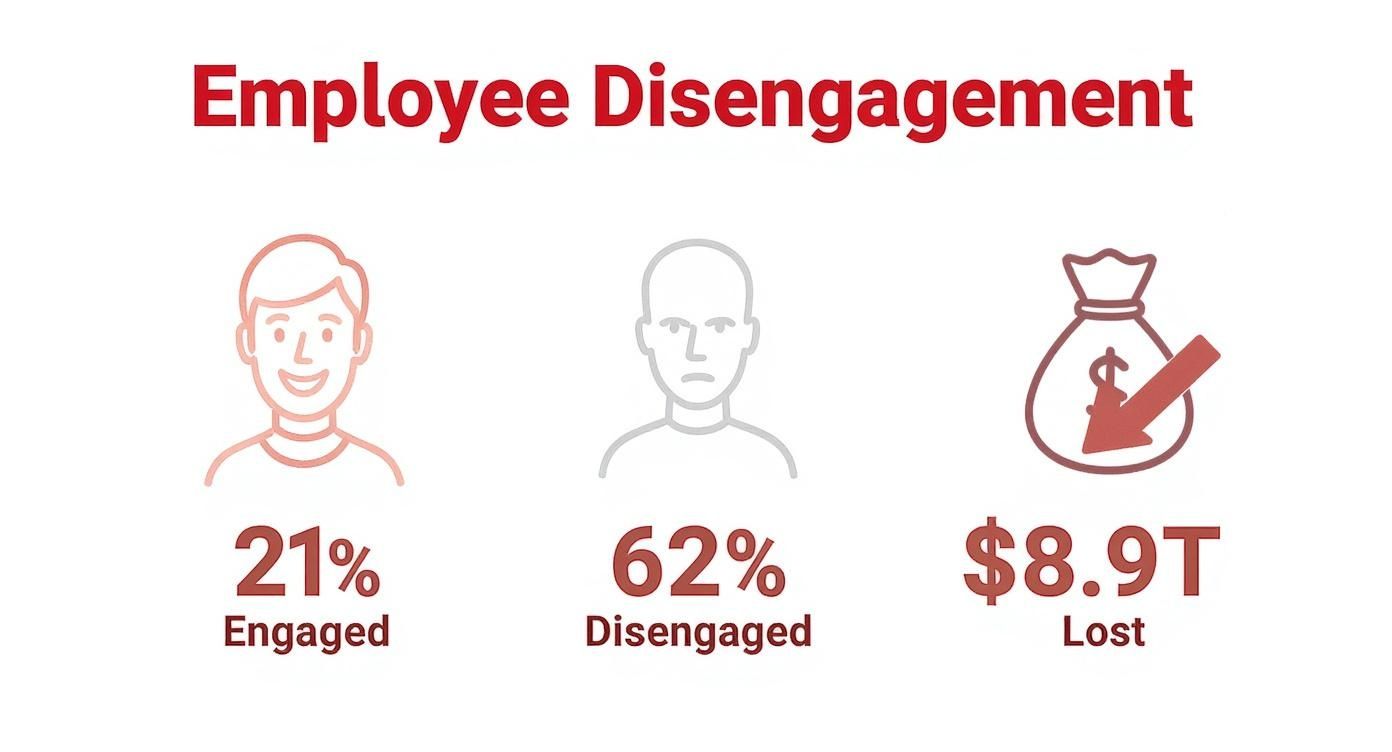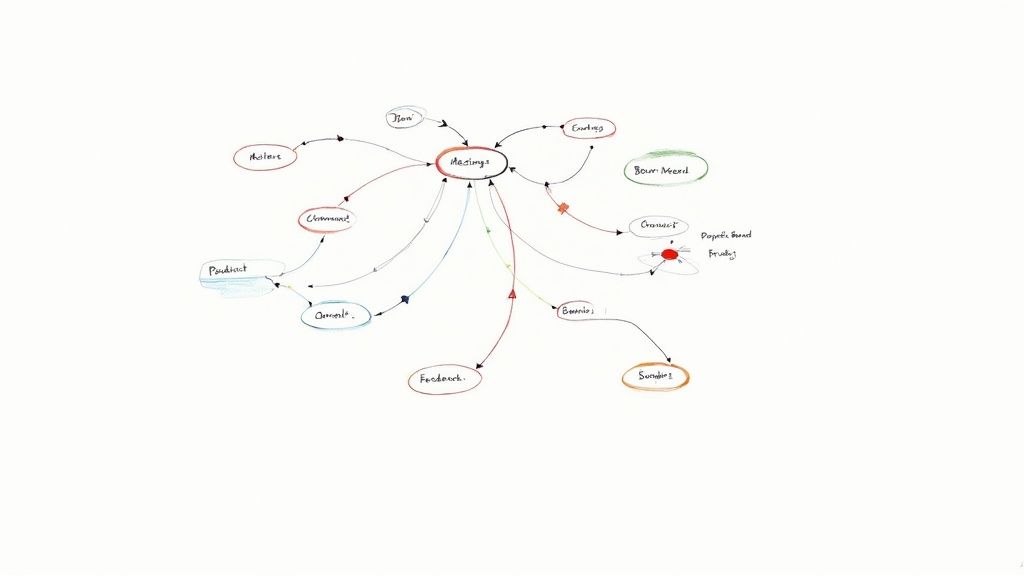Build a high-performing team: proven strategies for success

If you're serious about building a high-performing team, you need to look past the corporate jargon and get intentional about your approach. This isn't about luck or just hiring smart people; it's about architecting an environment where exceptional results become the standard operating procedure. That means building a foundation of psychological safety, clear goals, and real, shared accountability.
Defining What High Performance Really Means

It’s easy to confuse long hours with high output, but that’s a classic mistake. True performance is about getting superior results efficiently and sustainably. It’s the magic that happens when a group of talented individuals stops working in silos and starts operating as a cohesive, deeply aligned unit.
This kind of synergy doesn't just happen. It's the direct result of a carefully constructed framework, one that rests on a few core, non-negotiable principles. When you get these elements right, they create a powerful, self-reinforcing cycle of success.
To understand these foundational components, let's break them down into their essential parts.
| Pillar | Description | Key Outcome |
|---|---|---|
| Psychological Safety | The shared belief that it's safe to take risks, voice opinions, or admit mistakes without fear of blame. | Increased innovation, faster problem-solving, and higher engagement. |
| Clear Goals | A deep, collective understanding of what the team needs to achieve and, just as importantly, why it matters. | Focused effort, better decision-making, and a strong sense of purpose. |
| Mutual Accountability | A culture where team members hold each other to high standards, not just relying on a manager to enforce them. | Collective ownership, improved quality of work, and enhanced trust. |
These pillars aren't just feel-good concepts; they're the tangible building blocks of any truly elite team.
Getting the Core Components Right
So, how do we bring these ideas to life? It starts with deliberately embedding them into your team’s DNA.
First up is psychological safety. This is the bedrock. It's the difference between a team that plays it safe and one that innovates. When your people feel they can challenge an idea, ask a "dumb" question, or own up to a mistake without getting shut down, that's when the real breakthroughs happen.
Next, you need crystal-clear goals. Everyone on the team should be able to articulate what success looks like and how their individual work contributes to it. Ambiguity is the enemy of performance. When goals are specific, measurable, and tied to the bigger picture, they act as a North Star, guiding every decision.
Finally, there's mutual accountability. In the best teams I've seen, accountability flows in every direction—not just from the top down. It’s about peers holding each other to a high standard because they share a genuine commitment to the outcome. They celebrate wins together and, more importantly, they own the failures as a team.
These aren't just abstract ideals; they are actionable goals. To dive deeper into the practicalities, a comprehensive guide on building high-performing teams offers some fantastic insights.
The Real Price of a Team That's Just... Fine
Before we dive into building a stellar team, let's talk about the alternative. An underperforming team isn't just about missing a deadline here or there. It's a silent killer of resources, morale, and your company's future. It slowly creates a culture of "good enough" that’s incredibly tough to shake.
The most obvious sign? Disengagement. When people don't see the point in their work or feel disconnected from the team's mission, they don't just stop coming up with great ideas—they stop trying altogether. This kind of quiet quitting can be even more destructive than open conflict because it's so easy to ignore.
The Damage to Your Bottom Line and Your Culture
This indifference comes with a shocking price tag. According to Gallup's 2023 state of the global workforce report, a mere 23% of employees are actually engaged at work. A whopping 59% are "quiet quitting"—just going through the motions. This widespread apathy adds up to an estimated $8.9 trillion in lost productivity every year, which is about 9% of the entire global GDP.
That isn't just some abstract number. It's wasted human potential, missed market opportunities, and a clear signal that your people feel ignored. The financial hit is massive, but the long-term damage to your culture can be far more difficult to fix.
An underperforming team doesn't just fail to deliver. It actively corrodes the trust, psychological safety, and ambition your organization needs to thrive. It quietly lowers the bar for everyone.
Getting to the Root of the Problem
Facing this reality is the first step. The issues that tank a team’s performance are rarely one-off events. They're usually systemic problems that have been festering for a long time.
Spotting the signs early is your best bet. Here are a few of the usual suspects I've seen derail otherwise talented teams:
- Fuzzy Goals: When nobody knows what the "North Star" is, people drift. They might be working hard, but they're pulling in different directions, which just leads to wasted effort and frustration.
- Poor Management: A manager who doesn't provide support, can't give constructive feedback, or fails to clear roadblocks can single-handedly cripple a team's drive.
- No Psychological Safety: If people are afraid to speak up, admit a mistake, or pitch a wild idea, they'll play it safe. This is where innovation goes to die.
- Murky Roles: Ambiguity is a breeding ground for conflict. When no one is sure who owns what, tasks get dropped, and resentment starts to build.
By looking these issues square in the eye, you can reframe the cost of doing nothing. The investment you make to build a high-performing team is a drop in the bucket compared to the compounding cost of letting mediocrity take root.
How Transformational Leaders Inspire Excellence
High-performing teams don't just happen. They are a direct reflection of their leadership. A manager who simply doles out tasks and watches the clock might get the job done, but a true leader inspires a kind of commitment that lifts the entire group to a new level. This is the crucial shift from just directing work to inspiring excellence.
Great leaders know their main job is creating an environment where talented people can truly thrive. This means getting specific and moving beyond generic advice. It’s about building trust, fostering real autonomy, and creating the psychological safety that allows people to innovate without fear. It’s also about giving direct, honest feedback with radical candor.
The Widening Leadership Gap
Here’s the problem: there's a huge disconnect between the need for strong leadership and what’s actually happening in most companies. According to a 2023 report by DDI, leadership depth is a critical predictor of performance, yet a staggering 77% of organizations report a leadership talent shortage at every level.
This gap has real consequences. Trust in leaders is a major factor in employee retention and engagement. The infographic below shows the jaw-dropping cost of disengagement—a direct symptom of this leadership vacuum.

These numbers aren't just statistics; they represent a massive loss of human potential and productivity, all stemming from a failure to connect with and inspire teams.
From Boss to Leader: Making the Shift
Moving from being a "boss" to a "leader" takes conscious effort and a change in daily habits. A boss directs through authority; a leader inspires through influence and trust. This is where emotional intelligence becomes non-negotiable. For a deeper look, check out our guide on what emotional intelligence in leadership truly means.
The fundamental difference is that a boss creates followers, while a leader cultivates other leaders. They empower their teams by providing context and trusting them to find the best path forward.
Think about a real-world scenario. A project hits a major, unexpected snag. A boss might demand a solution and start looking for someone to blame for the missed deadline. A transformational leader, on the other hand, pulls the team together and asks, "What can we learn from this?" They focus the group on solving the problem together, which builds resilience and reinforces a sense of shared ownership.
For leaders looking to sharpen these skills, working with an expert can make all the difference. Sometimes, the personalized guidance from a business coach is what it takes to turn theory into practice.
Daily Habits of Inspiring Leaders
Ready to start building more trust and elevating your team’s performance right now? Try weaving these habits into your daily routine:
- Ask, Don't Tell: Instead of giving orders, ask powerful questions. "What do you think is the best approach here?" or "What's getting in your way that I can help remove?"
- Share the 'Why': Always link daily tasks back to the bigger picture. When people see the purpose behind their work, their motivation and the quality of their output skyrockets.
- Celebrate Effort, Not Just Wins: Acknowledge the grind. Recognize the hard work and learning that happens during a tough project, even if the result isn't a clear-cut victory. This encourages smart risk-taking.
- Practice Active Listening: In every single conversation, make a conscious effort to understand before trying to be understood. It’s a simple act, but it’s one of the most powerful trust-builders there is.
Designing Your Team's Communication System

Great communication isn't just a "nice-to-have." It’s the central nervous system of any successful team. When information flows freely and clearly, everything clicks. But when it gets bogged down or misinterpreted, even the most brilliant people can't perform at their best. It's the difference between a finely tuned machine and a box of spare parts.
The impact here is huge, and it's backed by some sobering numbers. A Salesforce report found that 86% of employees and executives cite a lack of collaboration or ineffective communication as the reason for workplace failures. On the flip side, research by McKinsey shows that well-connected teams can see a productivity bump of 20-25%. It's not just about avoiding failure; it's about actively building a massive competitive advantage. You can dig into more stats on how communication drives business outcomes if you're curious.
Set Up Clear Channels and Ground Rules
Building a high-performance team means being deliberate about how you talk to each other. Ambiguity is a project killer. The first thing I always do is map out our communication channels so there’s zero confusion about where to find what.
- Urgent Needs: What really counts as urgent? Define it. Then, assign a specific channel for it, like a direct message in Slack or a phone call. This stops every little thing from becoming a five-alarm fire.
- Project Central: Keep all project-related updates and files in one place, like Asana or Trello. This creates a single source of truth so nobody has to waste time hunting through endless email chains.
- Casual & Quick Stuff: A team chat app like Slack or Microsoft Teams is perfect for quick questions and building team rapport. Just make sure to set expectations around response times to help everyone maintain a healthy work-life balance.
Once the channels are clear, you need some ground rules—the "norms" that guide how you interact. For example, a great one is: "No big decisions over chat. Ever." If a conversation gets complex, you hop on a call. This simple rule has saved my teams from countless misunderstandings.
Build a Culture of Transparency and Feedback
Transparency is the bedrock of trust. When your team understands the "why" behind their tasks and can see how their work fits into the bigger picture, their sense of ownership skyrockets. This is where those project management tools really shine—they make progress, and problems, visible to everyone in real time.
But transparency without feedback is a one-way street. The best teams I've ever been on were obsessed with getting better, and that’s impossible without honest, constructive feedback. You have to cultivate an environment where feedback is treated as a valuable gift, not a personal attack.
A healthy communication system isn’t just about pushing information out. It’s about creating a safe space for dialogue to flow in every direction—from peer to peer, from team members to leadership, and back down—without anyone fearing negative consequences.
To make this happen, you need to give your people the right tools. I’m a big fan of frameworks like the Situation-Behavior-Impact (SBI) model, which helps frame feedback constructively. If you want to get a clearer picture of where your team stands, you might want to look into some communication assessment tools. They can highlight hidden strengths and weak spots, giving you a solid starting point for improvement.
A Practical Guide to Nurturing Talent
Putting together the right group of people is where all the theory gets real. Building a truly high-performing team means you need a repeatable way to attract, grow, and keep top talent. The secret isn't about finding a lineup of perfect, ready-made candidates. It's about creating an environment where talented people can mesh and evolve into an unstoppable force.
It all starts with rethinking how you hire. Too many organizations get hung up on "culture fit," which can easily become a trap that leads to a homogenous team where everyone thinks and acts the same. Instead, try hiring for culture-add. This means actively seeking out people who bring fresh perspectives and unique skills that fill your gaps and elevate the entire group. It’s a subtle but powerful shift from simply replicating what you already have to intentionally building what you need for the future.
From Candidate to Contributor
A strong start is everything. Even your most brilliant new hire can falter if they're not properly introduced to the team’s standards and how things really get done. A well-designed onboarding process ensures that from day one, new members understand not just their specific job, but the team's overarching mission, its communication quirks, and what success actually looks like here.
A great onboarding experience is more than just paperwork and a welcome lunch. It’s the first and most powerful signal you send about your commitment to an individual's success and integration into the team's high-performance culture.
Think about this: according to research compiled by Brandon Hall Group, organizations with a strong onboarding process improve new hire retention by a staggering 82% and boost productivity by over 70%. This isn’t about making someone feel warm and fuzzy; it’s a strategic investment in their long-term value. The goal is simple: dramatically shorten the time it takes for a new person to become a fully integrated, valuable contributor.
Fostering Continuous Growth and Momentum
Once you have someone on board, the real work of nurturing their talent has only just begun. High performers are fueled by growth and the pursuit of mastery. If they feel like they’re treading water, they’ll start looking for deeper seas. That’s why continuous development isn't a "nice-to-have"—it's a non-negotiable part of keeping your best people.
Creating personalized growth plans is a powerful way to show you’re genuinely invested in their careers. I’m not talking about generic corporate training modules. These should be collaborative roadmaps, co-created to align an individual's personal ambitions with the team's pressing needs.
Here’s how you can put this into action:
- Frequent Coaching Sessions: Ditch the annual review as your primary feedback tool. Regular, informal check-ins are where real coaching happens. They create space for immediate feedback, quick course corrections, and celebrating small wins along the way.
- Skill-Stretching Opportunities: Be on the lookout for chances to push your team members. This could be handing them a challenging new project, sending them to a specialized workshop, or asking them to mentor a junior colleague.
- Celebrate Wins, Big and Small: Recognition is the fuel that maintains momentum. Publicly acknowledging both individual achievements and team milestones reinforces the right behaviors and builds a shared sense of accomplishment.
This continuous cycle of hiring for add, onboarding with purpose, and developing relentlessly is the backbone of any sustainable talent system. For a more detailed look at building this kind of holistic approach, our guide on integrated talent management provides some excellent frameworks. At the end of the day, nurturing the talent you have is the most direct path to consistently achieving incredible results.
Common Questions on Building Elite Teams
When you move from the theory of team building to the reality of managing people, the questions get a lot harder. The day-to-day challenges of leading a team often don't have textbook answers. Here are my straight-up answers to some of the toughest, most common questions I hear from leaders.
How Do You Turn Around an Underperforming Team?
Before you do anything else, you have to figure out why the team is struggling. Don't jump to conclusions or start making changes. Your first move should be to conduct confidential one-on-one "stay interviews" with every single person. The goal here isn't to assign blame but to create a safe space where you can understand their individual frustrations and what actually motivates them.
Once you have that context, the next step is to create absolute clarity. Underperformance almost always stems from ambiguity. Get the team in a room (or a video call) and work together to redefine your core mission and immediate goals. Make sure every person can tell you exactly what they are responsible for and how their work connects to the bigger picture.
With that foundation, the root cause usually becomes obvious.
- Is it a skills gap? If so, you need to invest in targeted training or coaching.
- Is it a motivation issue? This is a leadership problem. It points to a need for better recognition, a stronger connection to purpose, or a change in your own style.
- Is it a process problem? This means the workflows themselves are broken and creating friction. Fix the system.
Finally, give the team a small, achievable project—a "quick win." Nailing a short-term goal builds momentum and, more importantly, restores their confidence. Celebrate that win publicly to signal that things are turning around.
What Is the Most Important Factor for Long-Term Success?
Lots of things matter, but if I have to pick one, it's psychological safety. It's the bedrock that everything else is built on. It's not a fluffy concept; Google's famous Project Aristotle study identified it as the single most critical dynamic in their highest-performing teams.
Psychological safety is simply the shared belief that it's okay to take interpersonal risks. It means people aren't afraid of being humiliated or punished for speaking up, asking a "dumb" question, or admitting a mistake.
Without psychological safety, you will never get the honest feedback, creative ideas, or resilience needed to adapt and overcome challenges. It is the foundation upon which trust, accountability, and innovation are built.
A team that feels safe learns from failure instead of hiding it. As a leader, you have to model this behavior. Be vulnerable yourself. When someone makes a mistake, respond with curiosity, not blame. Encourage respectful debate. This is how you create an environment where people feel secure enough to bring their best ideas to the table.
Can You Build a High-Performing Team Remotely?
Yes, you absolutely can, but it takes a much more deliberate effort than it does when everyone's in the same building. High performance has always been about culture and process, not physical location. The principles don't change, but how you apply them has to adapt.
For a remote team to really click, you have to over-communicate the "why" behind the work to keep everyone aligned and motivated. You also need to establish crystal-clear rules of engagement for both synchronous (like video calls) and asynchronous communication (like Slack or a project tool). If you don't, you'll burn people out with endless meetings and notifications.
You also have to be intentional about creating the social bonds that happen naturally in an office. This might mean virtual coffee breaks, dedicated non-work chat channels, or even structured online team-building. Most importantly, you have to trust your people. Ditch the urge to micromanage and focus on outcomes, not hours logged. A solid tech stack that makes collaboration feel seamless is the final, crucial piece of the puzzle.
Ready to build a stronger, more cohesive team with data-driven insights? MyCulture.ai provides the tools you need to assess culture fit, streamline onboarding, and nurture the talent that drives high performance. Start making better people decisions today by visiting https://www.myculture.ai.